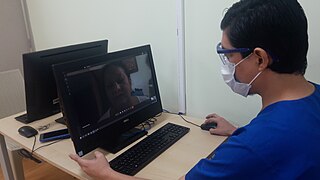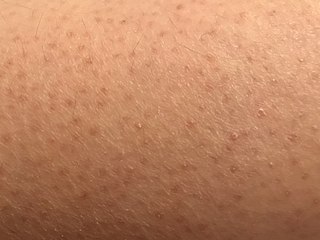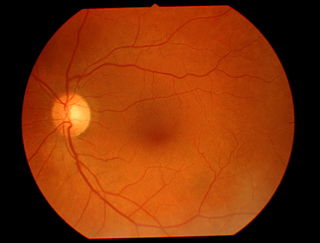Related Research Articles

A melanocytic nevus is usually a noncancerous condition of pigment-producing skin cells. It is a type of melanocytic tumor that contains nevus cells. Some sources equate the term mole with "melanocytic nevus", but there are also sources that equate the term mole with any nevus form.
Dermatology is the branch of medicine dealing with the skin. It is a speciality with both medical and surgical aspects. A dermatologist is a specialist medical doctor who manages diseases related to skin, hair, nails, and some cosmetic problems.

Melanoma, also redundantly known as malignant melanoma, is a type of cancer that develops from the pigment-producing cells known as melanocytes. Melanomas typically occur in the skin, but may rarely occur in the mouth, intestines, or eye. In women, they most commonly occur on the legs, while in men, they most commonly occur on the back. About 25% of melanomas develop from moles. Changes in a mole that can indicate melanoma include an increase in size, irregular edges, change in color, itchiness, or skin breakdown.

Nevus is a nonspecific medical term for a visible, circumscribed, chronic lesion of the skin or mucosa. The term originates from nævus, which is Latin for "birthmark"; however, a nevus can be either congenital or acquired. Common terms, including mole, birthmark, and beauty mark, are used to describe nevi, but these terms do not distinguish specific types of nevi from one another.

Telehealth is the distribution of health-related services and information via electronic information and telecommunication technologies. It allows long-distance patient and clinician contact, care, advice, reminders, education, intervention, monitoring, and remote admissions. Telemedicine is sometimes used as a synonym, or is used in a more limited sense to describe remote clinical services, such as diagnosis and monitoring. When rural settings, lack of transport, a lack of mobility, conditions due to outbreaks, epidemics or pandemics, decreased funding, or a lack of staff restrict access to care, telehealth may bridge the gap as well as provide distance-learning; meetings, supervision, and presentations between practitioners; online information and health data management and healthcare system integration. Telehealth could include two clinicians discussing a case over video conference; a robotic surgery occurring through remote access; physical therapy done via digital monitoring instruments, live feed and application combinations; tests being forwarded between facilities for interpretation by a higher specialist; home monitoring through continuous sending of patient health data; client to practitioner online conference; or even videophone interpretation during a consult.

Keratosis pilaris is a common, autosomal-dominant, genetic condition of the skin's hair follicles characterized by the appearance of possibly itchy, small, gooseflesh-like bumps, with varying degrees of reddening or inflammation. It most often appears on the outer sides of the upper arms, thighs, face, back, and buttocks; KP can also occur on the hands, and tops of legs, sides, or any body part except glabrous (hairless) skin. Often the lesions can appear on the face, which may be mistaken for acne or folliculitis.

A seborrheic keratosis is a non-cancerous (benign) skin tumour that originates from cells, namely keratinocytes, in the outer layer of the skin called the epidermis. Like liver spots, seborrheic keratoses are seen more often as people age.

Actinic keratosis (AK), sometimes called solar keratosis or senile keratosis, is a pre-cancerous area of thick, scaly, or crusty skin. Actinic keratosis is a disorder of epidermal keratinocytes that is induced by ultraviolet (UV) light exposure. These growths are more common in fair-skinned people and those who are frequently in the sun. They are believed to form when skin gets damaged by UV radiation from the sun or indoor tanning beds, usually over the course of decades. Given their pre-cancerous nature, if left untreated, they may turn into a type of skin cancer called squamous cell carcinoma. Untreated lesions have up to a 20% risk of progression to squamous cell carcinoma, so treatment by a dermatologist is recommended.

A dysplastic nevus or atypical mole is a nevus (mole) whose appearance is different from that of common moles. In 1992, the NIH recommended that the term "dysplastic nevus" be avoided in favor of the term "atypical mole". An atypical mole may also be referred to as an atypical melanocytic nevus, atypical nevus, B-K mole, Clark's nevus, dysplastic melanocytic nevus, or nevus with architectural disorder.

Dysplastic nevus syndrome, also known as familial atypical multiple mole–melanoma (FAMMM) syndrome, is an inherited cutaneous condition described in certain families, and characterized by unusual nevi and multiple inherited melanomas. First described in 1820, the condition is inherited in an autosomal dominant pattern, and caused by mutations in the CDKN2A gene. In addition to melanoma, individuals with the condition are at increased risk for pancreatic cancer.

Erythema ab igneEAI, also known as hot water bottle rash, is a skin condition caused by long-term exposure to heat. Prolonged thermal radiation exposure to the skin can lead to the development of reticulated erythema, hyperpigmentation, scaling, and telangiectasias in the affected area. Some people may complain of mild itchiness and a burning sensation, but often, unless a change in pigmentation is seen, it can go unnoticed.

Dermatoscopy also known as dermoscopy or epiluminescence microscopy, is the examination of skin lesions with a dermatoscope. It is a tool similar to a camera to allow for inspection of skin lesions unobstructed by skin surface reflections. The dermatoscope consists of a magnifier, a light source, a transparent plate and sometimes a liquid medium between the instrument and the skin. The dermatoscope is often handheld, although there are stationary cameras allowing the capture of whole body images in a single shot. When the images or video clips are digitally captured or processed, the instrument can be referred to as a digital epiluminescence dermatoscope. The image is then analyzed automatically and given a score indicating how dangerous it is. This technique is useful to dermatologists and skin cancer practitioners in distinguishing benign from malignant (cancerous) lesions, especially in the diagnosis of melanoma.

A blue nevus is a type of coloured mole, typically a single well-defined blue-black bump.

Skin biopsy is a biopsy technique in which a skin lesion is removed to be sent to a pathologist to render a microscopic diagnosis. It is usually done under local anesthetic in a physician's office, and results are often available in 4 to 10 days. It is commonly performed by dermatologists. Skin biopsies are also done by family physicians, internists, surgeons, and other specialties. However, performed incorrectly, and without appropriate clinical information, a pathologist's interpretation of a skin biopsy can be severely limited, and therefore doctors and patients may forgo traditional biopsy techniques and instead choose Mohs surgery.
FotoFinder is a worldwide brand for medical skin imaging systems. The German company FotoFinder Systems GmbH was founded in 1991 and has developed imaging solutions for the follow-up of skin lesions as well as hair disorders diagnostics (TrichoLAB) and psoriasis assessment.

Majocchi's granuloma is a skin condition characterized by deep, pustular plaques, and is a form of tinea corporis. It is a localized form of fungal folliculitis. Lesions often have a pink and scaly central component with pustules or folliculocentric papules at the periphery. The name comes from Domenico Majocchi, who discovered the disorder in 1883. Majocchi was a professor of dermatology at the University of Parma and later the University of Bologna. The most common dermatophyte is called Trichophyton rubrum.
Pseudomelanoma is a cutaneous condition in which melanotic skin lesions clinically resemble a superficial spreading melanoma at the site of a recent shave removal of a melanocytic nevus.

Teleophthalmology is a branch of telemedicine that delivers eye care through digital medical equipment and telecommunications technology. Today, applications of teleophthalmology encompass access to eye specialists for patients in remote areas, ophthalmic disease screening, diagnosis and monitoring; as well as distant learning.
First Derm is a US-based online dermatology and tele-health website providing answers to skin conditions. Users send in cases to board certified dermatologists via an iOS, Android or Web app.
International Dermoscopy Society (IDS) is a non-governmental organization offering comprehensive promotion of dermoscopy, also known as dermatoscopy. It has over 16,000 international members from over 160 different countries.
References
- ↑ "ATA Teledermatology SIG". American Telemedicine Association. Archived from the original on 2 February 2007.
- ↑ Wootton R (December 2017). "Realtime Telemedicine". In Wootton R, Craig J, Patterson V (eds.). Introduction to Telemedicine (Second ed.). CRC Press. p. 88. ISBN 978-1-351-98946-6.
- ↑ Wurm EM, Hofmann-Wellenhof R, Wurm R, Soyer HP (February 2008). "Telemedicine and teledermatology: Past, present and future". Journal of the German Society of Dermatology. 6 (2): 106–12. doi:10.1111/j.1610-0387.2007.06440.x. PMID 18005076. S2CID 41450493.
- ↑ Burg G, Soyer HP, Chimenti S (2005). "Teledermatology". In Frisch P, Burgdorf W (eds.). EDF White Book, Skin Diseases in Europe. Berlin. pp. 130–133.
{{cite book}}: CS1 maint: location missing publisher (link) - ↑ Perednia DA, Brown NA (January 1995). "Teledermatology: one application of telemedicine". Bulletin of the Medical Library Association. 83 (1): 42–7. PMC 225996 . PMID 7703938.
- ↑ Chuchu, Naomi; Dinnes, Jacqueline; Takwoingi, Yemisi; Matin, Rubeta N; Bayliss, Susan E; Davenport, Clare; Moreau, Jacqueline F; Bassett, Oliver; Godfrey, Kathie; O'Sullivan, Colette; Walter, Fiona M (4 December 2018). Cochrane Skin Group (ed.). "Teledermatology for diagnosing skin cancer in adults". Cochrane Database of Systematic Reviews. 2018 (12): CD013193. doi:10.1002/14651858.CD013193. PMC 6517019 . PMID 30521686.
- ↑ "Telederm.org". eDermConsult.
- ↑ Binder B, Hofmann-Wellenhof R, Salmhofer W, Okcu A, Kerl H, Soyer HP (December 2007). "Teledermatological monitoring of leg ulcers in cooperation with home care nurses". Archives of Dermatology. 143 (12): 1511–4. doi: 10.1001/archderm.143.12.1511 . PMID 18086999.
- ↑ Ford, Adam R.; Gibbons, Caitlin M.; Torres, Josefina; Kornmehl, Heather A.; Singh, Sanminder; Young, Paulina M.; Chambers, Cindy J.; Maverakis, Emanual; Dunnick, Cory A.; Armstrong, April W. (2019). "Access to Dermatological Care with an Innovative Online Model for Psoriasis Management: Results from a Randomized Controlled Trial". Telemedicine and e-Health. 25 (7): 619–627. doi:10.1089/tmj.2018.0160. ISSN 1530-5627. PMC 6417973 . PMID 30222518.
- ↑ "IDD International Dermoscopy Diploma". Medizinische Universität Graz. Archived from the original on 13 January 2011.
- ↑ "DermNet NZ". New Zealand Dermatological Society.
- ↑ Massone C, Soyer HP, Lozzi GP, Di Stefani A, Leinweber B, Gabler G, et al. (April 2007). "Feasibility and diagnostic agreement in teledermatopathology using a virtual slide system". Human Pathology. 38 (4): 546–54. doi:10.1016/j.humpath.2006.10.006. hdl:11567/255271. PMID 17270240.
- ↑
- Bauer J, Leinweber B, Metzler G, Blum A, Hofmann-Wellenhof R, Leitz N, et al. (September 2006). "Correlation with digital dermoscopic images can help dermatopathologists to diagnose equivocal skin tumours". The British Journal of Dermatology. 155 (3): 546–51. doi:10.1111/j.1365-2133.2006.07342.x. PMID 16911279. S2CID 39413421.
- ↑ "Handyscope". FotoFinder Systems GmbH. Archived from the original on 10 April 2020. Retrieved 27 November 2018.
- ↑ Snoswell C, Finnane A, Janda M, Soyer HP, Whitty JA (June 2016). "Cost-effectiveness of Store-and-Forward Teledermatology: A Systematic Review" (PDF). JAMA Dermatology. 152 (6): 702–8. doi:10.1001/jamadermatol.2016.0525. hdl:10072/410245. PMID 27074289. S2CID 4052611.
- ↑ Chuchu N, Takwoingi Y, Dinnes J, Matin RN, Bassett O, Moreau JF, et al. (December 2018). "Smartphone applications for triaging adults with skin lesions that are suspicious for melanoma". The Cochrane Database of Systematic Reviews. 2018 (12): CD013192. doi:10.1002/14651858.cd013192. PMC 6517294 . PMID 30521685.
- ↑
- Kaliyadan F, Venkitakrishnan S (2009). "Teledermatology: clinical case profiles and practical issues". Indian Journal of Dermatology, Venereology and Leprology. 75 (1): 32–5. doi: 10.4103/0378-6323.45217 . hdl: 1807/48327 . PMID 19172028.
- ↑ Schofield J, Grindlay D, Williams H. Skin conditions in the UK: a health care needs assessment. Nottingham: Centre of Evidence Based Dermatology, University of Nottingham, 2009.
- ↑ "The Operating Framework for the NHS in England 2011/12". Department of Health. GOV.UK.
- ↑ "Skin cancer responds to around 30% of all malignant tumors in the Country". Sociedade Brasileira de Medicina Tropical (in Portuguese). 2019.
- ↑ von Wangenheim A, Nunes DH (2019). "Creating a Web Infrastructure for the Support of Clinical Protocols and Clinical Management: An Example in Teledermatology". Telemed J e Health. 25 (9): 781–790. doi:10.1089/tmj.2018.0197. PMID 30499753. S2CID 54165649.
- ↑ Giavina Bianchi M, Santos A, Cordioli E (2021). "Dermatologists' perceptions on the utility and limitations of teledermatology after examining 55,000 lesions". J Telemed Telecare. 27 (3): 166–173. doi:10.1177/1357633X19864829. PMC 8044615 . PMID 31409225.
- ↑ Snoswell CL, Caffery LJ, Whitty JA, Soyer HP, Gordon LG (June 2018). "Cost-effectiveness of Skin Cancer Referral and Consultation Using Teledermoscopy in Australia". JAMA Dermatology. 154 (6): 694–700. doi:10.1001/jamadermatol.2018.0855. PMC 6145645 . PMID 29801161.
- ↑ Snoswell CL, Whitty JA, Caffery LJ, Finnane A, Soyer HP (August 2019). "What do Australian dermatologists expect to be paid for store-and-forward teledermoscopy? A preliminary investigation" (PDF). Journal of Telemedicine and Telecare. 25 (7): 438–444. doi:10.1177/1357633x18776766. PMID 29933722. S2CID 49389361.